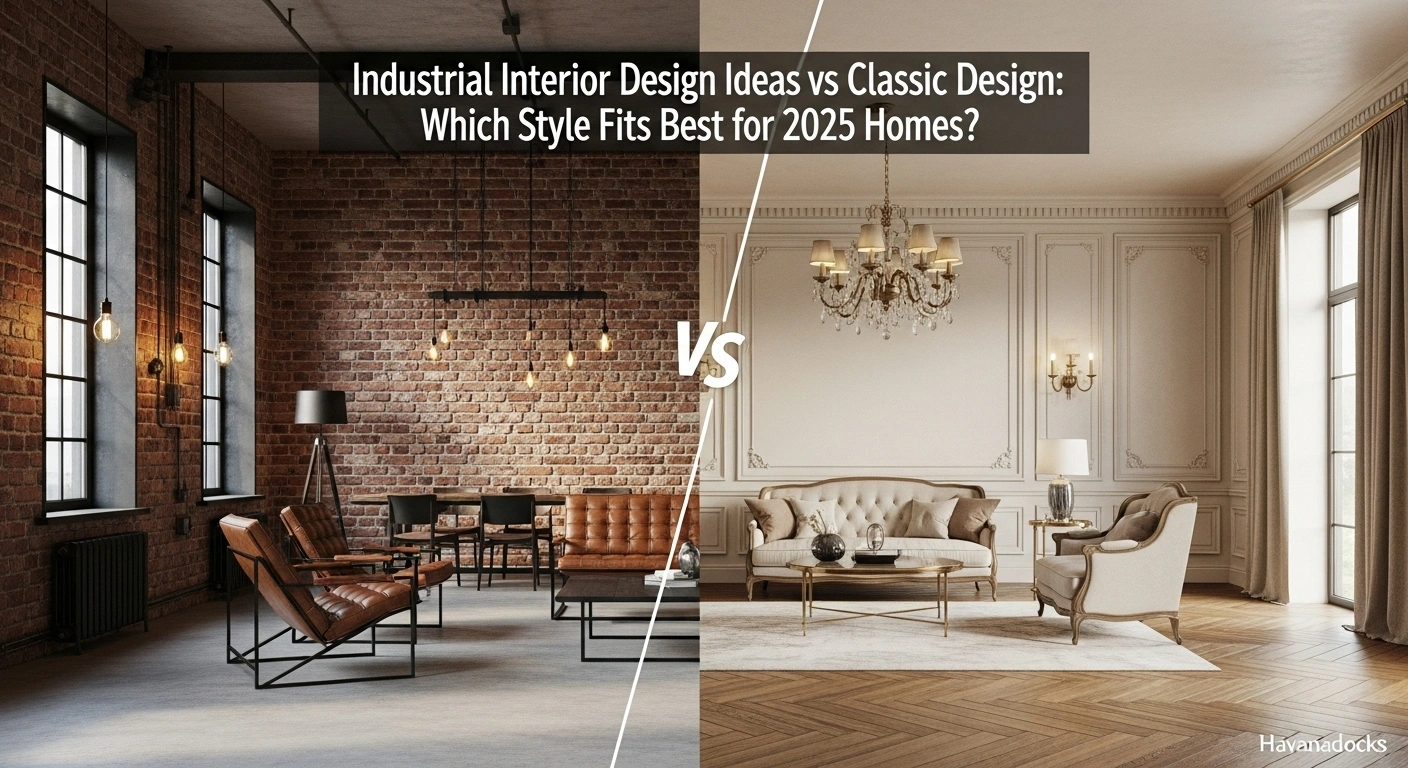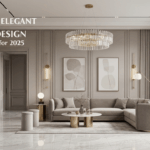Industrial Interior Design Ideas vs Classic Design: Which Style Fits Best for 2025 Homes?
Industrial Interior Design Ideas vs Classic Design – Choosing an interior design style is more than just picking out furniture; it is the art of crafting a personal sanctuary. Your home is a direct reflection of your personality, your aspirations, and the life you wish to lead. As we look towards 2025, two powerful and distinct aesthetics stand at the forefront of design conversations: the raw, edgy appeal of industrial design and the timeless, graceful elegance of classic design.
This decision presents a fascinating juxtaposition of philosophies. Do you gravitate towards the authentic, unvarnished honesty of a converted loft, or the stately, harmonious comfort of a traditional manor? The ongoing debate of Industrial Interior Design Ideas vs Classic Home Design is not about which is superior, but which is the perfect canvas for your unique story. This guide will illuminate the core principles of each style, helping you decide which path will lead to your dream home in 2025.

The Defining Crossroads: Raw Authenticity or Timeless Elegance?
At its heart, the choice between these two styles is a choice of expression. Industrial design champions the beauty of the unfinished, finding sophistication in raw materials and functional forms. It is a style born from repurposed factories and warehouses, celebrating history and mechanical ingenuity.
Conversely, classic home design is rooted in the principles of order, symmetry, and proportion, drawing inspiration from Greek and Roman antiquity. It speaks a language of refinement, using luxurious materials and ornate details to create a sense of calm and established grace. The fundamental question in the Industrial Interior Design Ideas vs Classic Home Design dilemma is whether your soul craves the vibrant energy of the urban or the serene composure of the traditional.
The Allure of the Urban Loft: Embracing Industrial Interior Design Ideas
Industrial interior design is a bold declaration of confidence and style. It strips away the non-essential, revealing the very bones of a structure and celebrating them as art. This aesthetic is perfect for those who appreciate history, craftsmanship, and a space that feels both expansive and intimate.
This style is characterized by its open-plan layouts, high ceilings, and large windows that flood the space with natural light. It creates an environment that is perfect for modern living, socializing, and creative pursuits. Exploring industrial interior design ideas means embracing a look that is unapologetically honest and effortlessly cool. When considering Industrial Interior Design Ideas vs Classic Home Design, the industrial approach offers a unique sense of freedom and character.
The Foundation: Exposed Materials and Raw Textures
The soul of industrial design lives in its materials. Think of weathered brick walls that tell a story, their imperfections adding layers of character to the room. See polished concrete floors, sleek and durable, providing a neutral canvas for your life to unfold upon.
Look up, and you might see exposed ductwork, pipes, and wooden beams, no longer hidden but celebrated as integral parts of the design’s machinery. These elements create a rich tactile experience, a constant reminder of the building’s history and purpose. This raw foundation is the cornerstone of authentic industrial appeal.
This honest approach to materials is a major point of difference in the Industrial Interior Design Ideas vs Classic Home Design comparison. The raw textures provide a rugged backdrop that feels both historic and contemporary. It’s a design that doesn’t hide its origins; it puts them on full display.
A Palette of Neutrality and Metal Accents
The industrial color palette is sophisticated and restrained, drawing from the source materials themselves. Shades of gray, from charcoal to dove, dominate, complemented by stark whites, deep blacks, and the warmth of natural wood and brick. This neutral scheme creates a sense of spaciousness and allows the structural elements and furniture to take center stage.
Metal is the primary accent material, providing both form and function. Blackened steel, brushed nickel, copper, and cast iron are used extensively in lighting fixtures, window frames, furniture legs, and railings. These metallic elements add a sleek, modern edge that contrasts beautifully with the rawer textures of brick and wood. The thoughtful use of this palette is a key factor when evaluating Industrial Interior Design Ideas vs Classic Home Design.
This interplay of cool metals and warm, natural textures is what gives industrial design its dynamic energy. It feels balanced, purposeful, and intentionally curated. The result is a space that is visually calm yet full of interesting details.
Furniture as Functional Sculpture
Furniture in an industrial space is chosen for its functionality, durability, and strong silhouette. Pieces often feature a mix of reclaimed wood and metal, appearing as if they were salvaged from a vintage workshop. Think of a large dining table with a solid wood top and a robust cast-iron base.
Sofas and chairs often feature worn leather or durable, neutral-toned fabrics, prioritizing comfort and longevity. Shelving is frequently open and utilitarian, using metal pipes or simple wooden planks to display books and objects. The key is that each piece feels substantial and serves a clear purpose, blurring the line between furniture and functional sculpture.
Lighting is a critical element, acting as the jewelry of the industrial space. Iconic Edison bulbs with their visible filaments, large metal pendant lights hanging low over a kitchen island, and articulated floor lamps are all hallmarks of the style. This focus on practical yet beautiful objects is a significant consideration in the Industrial Interior Design Ideas vs Classic Home Design debate.
The Enduring Charm of Classic Home Design
Classic home design is an ode to timelessness and grace. It is a style that has endured for centuries, creating spaces that feel stately, comfortable, and endlessly elegant. Rooted in order and harmony, it provides a tranquil and sophisticated retreat from the chaos of the modern world.
This aesthetic is for those who appreciate fine craftsmanship, rich materials, and a home that exudes a sense of permanence and refined taste. Classic design is not about chasing trends; it’s about investing in a style that will remain beautiful and relevant for generations. For many homeowners, the security of this timelessness resolves the Industrial Interior Design Ideas vs Classic Home Design question decisively.
Classic interiors are meticulously planned, where every element has its place and contributes to a cohesive, harmonious whole. From the architectural details to the carefully chosen accessories, the goal is to create a space that is both visually stunning and deeply comforting. It is a celebration of beauty in its most refined form.
The Principles of Symmetry and Order
The bedrock of classic design is symmetry. A typical classic living room is organized around a central focal point, such as a grand fireplace with an ornate mantelpiece or a large, elegant piece of art. The furniture and decor are then arranged in a balanced, often mirrored, fashion on either side of this focal point.
This deliberate arrangement creates a sense of visual calm and stability. It guides the eye through the space in a predictable and pleasing way, making the room feel organized and serene. Architectural details like elaborate crown moldings, wainscoting, and decorative cornices further enhance this sense of order and grandeur.
These principles of balance and formality are what truly set this aesthetic apart in the Industrial Interior design Ideas vs Classic Home Design discussion. While industrial design finds beauty in asymmetry and raw form, classic design finds it in precision and perfect harmony. It’s a carefully composed look that speaks of intention and control.

A Rich and Refined Material & Color Palette
The materials used in classic design are chosen for their quality and luxurious feel. Polished hardwoods like mahogany, cherry, and walnut are common for flooring and furniture, often inlaid with intricate patterns. Countertops and fireplace surrounds frequently feature elegant marble or granite, adding a touch of natural splendor.
Fabrics are equally opulent, with silk, velvet, brocade, and damask used for drapery, upholstery, and cushions. These rich textiles add depth, texture, and a sense of indulgence to the space. The color palette can range from soft and airy neutrals—creams, beiges, and pale greens—to deep, jewel-toned hues like navy, emerald, and burgundy, creating a sense of drama and sophistication.
This commitment to high-end materials is a defining characteristic of the style. The debate of Industrial Interior Design Ideas vs Classic Home Design often comes down to this preference for raw authenticity versus polished luxury. Both are beautiful, but they appeal to very different sensibilities.
The Grandeur of Traditional Classic
Within the classic style, there are variations in intensity. The more traditional approach embraces ornamentation with a lavish hand. This is a style of opulence and intricate detail.
Furniture in this sub-style features carved legs, detailed scrollwork, and gilded accents. Crystal chandeliers drip from the ceiling, and heavily layered window treatments with valances and tassels frame the views. Patterns are complex and rich, recalling the grandeur of European palaces and country estates. This is the perfect choice for those who want their home to be a statement of unapologetic luxury.
The Simplicity of Neoclassical
For those who love classic principles but prefer a slightly more restrained look, Neoclassical design is the answer. It maintains the core tenets of symmetry, order, and classical motifs but with cleaner lines and less ornamentation. This style is a more streamlined and often brighter interpretation of classicism.
Furniture shapes are elegant but simpler, drawing inspiration directly from ancient Greek and Roman forms. The color palette is often lighter and more muted, relying on the beauty of form rather than heavy decoration. This approach offers the timelessness of classic design with a slightly more modern and approachable feel, providing a middle ground for some in the Industrial Interior Design Ideas vs Classic Home Design choice.
2025 and Beyond: Making the Right Choice for Your Lifestyle
As we look to 2025, the best design for your home is the one that aligns seamlessly with your lifestyle, personality, and practical needs. The Industrial Interior Design Ideas vs Classic Home Design discussion is less about which trend is “in” and more about which world you want to inhabit daily. Let’s break down the decision based on key lifestyle factors.
Your daily routine, family needs, and how you entertain should guide your choice. A home is a living space, and its design must support, not hinder, your life. The perfect 2025 home is one that feels like a natural extension of who you are.
Personality and Atmosphere
Your home’s atmosphere should resonate with your inner self. If you are dynamic, creative, and drawn to the energy of the city, industrial design might be your perfect match. It creates a backdrop that feels inspiring, social, and a bit rebellious, ideal for someone who loves open spaces and unconventional beauty.
If you are someone who values tranquility, tradition, and quiet sophistication, classic design will likely feel more like home. It fosters an atmosphere of calm, comfort, and refined elegance, perfect for those who enjoy formal entertaining, quiet evenings, and a sense of established order. This is the most personal aspect of the Industrial Interior Design Ideas vs Classic Home Design decision.
Functionality and Open-Plan Living
The modern trend towards open-concept living finds a natural ally in industrial design. The style’s origins in large, undivided factory floors mean it is perfectly suited for combining the kitchen, dining, and living areas into one cohesive, social space. This is ideal for families and those who love to entertain casually, as it promotes interaction and a sense of togetherness.
Classic design, by contrast, traditionally favors more defined, separate rooms. While it can be adapted to an open plan, its essence lies in creating distinct zones for different activities—a formal dining room, a cozy living room, a private study. This can be perfect for those who crave privacy and a more structured home environment. The layout preference is a major differentiator in the Industrial Interior Design Ideas vs Classic Home Design comparison.

Maintenance and Durability
Consider the practicalities of upkeep. The robust materials of industrial design—concrete, brick, metal—are incredibly durable and often low-maintenance. Scratches and scuffs can even add to the “worn-in” charm, making it a forgiving choice for households with pets or young children.
Classic design, with its polished hardwoods, luxurious fabrics, and delicate details, often requires more careful maintenance. Silk drapery, velvet upholstery, and high-gloss wood finishes need regular cleaning and gentle handling to preserve their beauty. This commitment to upkeep is a crucial factor when weighing Industrial Interior Design Ideas vs Classic Home Design.
Budget and Investment
The budget can play a significant role in your decision. Sourcing authentic reclaimed materials for an industrial design can be costly, but the style also embraces a more “found objects” approach, allowing for creative and budget-friendly solutions. The aesthetic’s emphasis on fewer, more functional pieces can also lead to savings.
Classic design often involves a higher initial investment due to its reliance on high-quality materials, expert craftsmanship, and detailed architectural work. However, these pieces are seen as long-term investments that hold their value and never go out of style. Understanding your financial comfort zone is key in the Industrial Interior Design Ideas vs Classic Home Design equation.
The 2025 Hybrid: The Best of Both Worlds
Perhaps the most exciting trend for 2025 is the rejection of rigid style boundaries. You don’t have to choose a side in the Industrial Interior Design Ideas vs Classic Home Design debate. A beautiful, highly personalized home can be created by masterfully blending elements from both.
Imagine an industrial loft with exposed brick walls and concrete floors, but furnished with a classic, plush Chesterfield sofa and an elegant crystal chandelier. Or consider a classic home with beautiful crown molding and symmetrical layouts, accented with sleek, black metal light fixtures and a minimalist steel-framed coffee table. This “Industrial-Chic” or “Modern-Classic” approach allows you to enjoy the raw character of one style with the refined comfort of the other.
This fusion creates a space that is layered, unique, and full of personality. It shows a deep appreciation for design history while looking firmly towards the future. For many, this hybrid solution is the ultimate answer to creating a perfect home for 2025.
Conclusion: Crafting Your Personal Sanctuary
Ultimately, the choice in the great debate of Industrial Interior Design Ideas vs Classic Home Design is a deeply personal one. There is no right or wrong answer, only the answer that is right for you. Both styles offer a powerful vision for a beautiful home, but they speak to different desires and cater to different lifestyles.
Industrial design offers a world of raw authenticity, open spaces, and urban sophistication. Classic design provides a haven of timeless elegance, ordered tranquility, and refined luxury. Look at the images, consider your daily life, and listen to what your heart desires for the space you call home.
As you plan your home for 2025, ask yourself: Do I want to live in a functional work of art that celebrates its history, or a serene and graceful retreat that transcends time? The answer will guide you to a style that is not just a design choice, but the truest expression of yourself. Your perfect home awaits.






